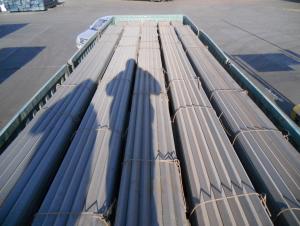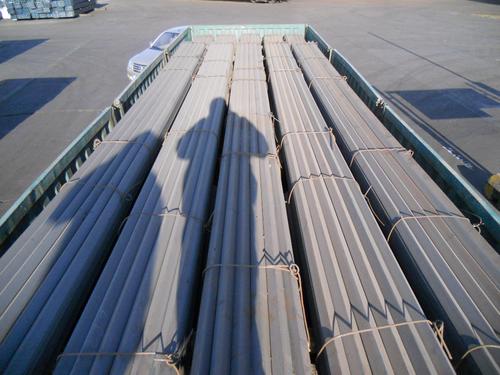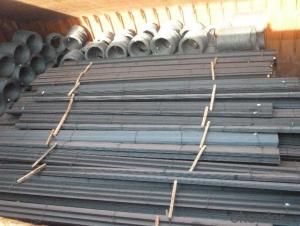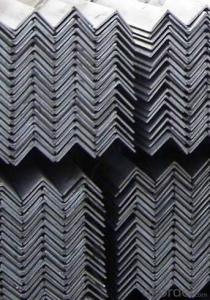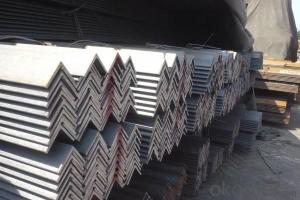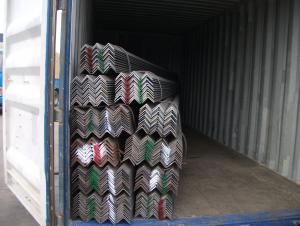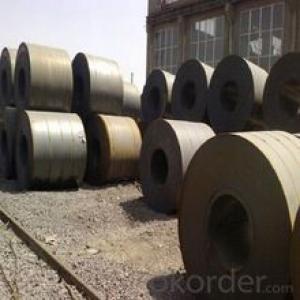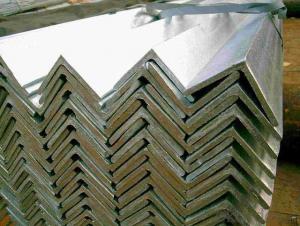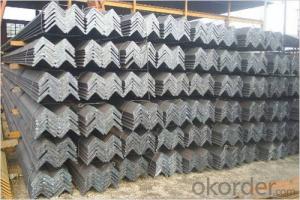JIS SS400 Hot Rolled Angle Steel
- Loading Port:
- China Main Port
- Payment Terms:
- TT or LC
- Min Order Qty:
- -
- Supply Capability:
- -
OKorder Service Pledge
OKorder Financial Service
You Might Also Like
Product Description:
OKorder is offering high quality Angle Steel at great prices with worldwide shipping. Our supplier is a world-class manufacturer of steel, with our products utilized the world over. OKorder annually supplies products to European, North American and Asian markets. We provide quotations within 24 hours of receiving an inquiry and guarantee competitive prices.
Product Applications:
According to the needs of different structures, Angle can compose to different force support component, and also can be the connections between components. It is widely used in various building structures and engineering structures such as roof beams, bridges, transmission towers, hoisting machinery and transport machinery, ships, industrial furnaces, reaction tower, container frame and warehouse etc.
.
Product Advantages:
OKorder's Angle Steel are durable, strong, and resist corrosion.
Main Product Features:
· Premium quality
· Prompt delivery & seaworthy packing (30 days after receiving deposit)
· Corrosion resistance
· Can be recycled and reused
· Mill test certification
· Professional Service
· Competitive pricing
Product Specifications:
1.Standards:GB,ASTM,BS,AISI,DIN,JIS
2.Invoicing on theoretical weight or actual weight as customer request
3.Material: JIS G3192,SS400;SS540.
4. Payment terms:
1).100% irrevocable L/C at sight.
2).30% T/T prepaid and the balance against the copy of B/L.
3) 30% T/T prepaid and the balance against L/C
4. Material Specifications:
Grade | Yield Strength,N/mm² | Extension Strength N/mm² | |||
Thickness of Steel,mm | |||||
≦16 | >16-≦40 | >40-≦100 | >100 | ||
SS330 | ≧205 | ≧195 | ≧175 | ≧165 | 330-430 |
SS400 | ≧245 | ≧235 | ≧215 | ≧205 | 400-510 |
SS490 | ≧285 | ≧275 | ≧255 | ≧245 | 490-610 |
SS540 | ≧400 | ≧390 | - | - | ≧540 |
FAQ:
Q1: Why buy Materials & Equipment from OKorder.com?
A1: All products offered byOKorder.com are carefully selected from China's most reliable manufacturing enterprises. Through its ISO certifications, OKorder.com adheres to the highest standards and a commitment to supply chain safety and customer satisfaction.
Q2: How do we guarantee the quality of our products?
A2: We have established an advanced quality management system which conducts strict quality tests at every step, from raw materials to the final product. At the same time, we provide extensive follow-up service assurances as required.
Q3: How soon can we receive the product after purchase?
A3: Within three days of placing an order, we will begin production. The specific shipping date is dependent upon international and government factors, but is typically 7 to 10 workdays.
Images:
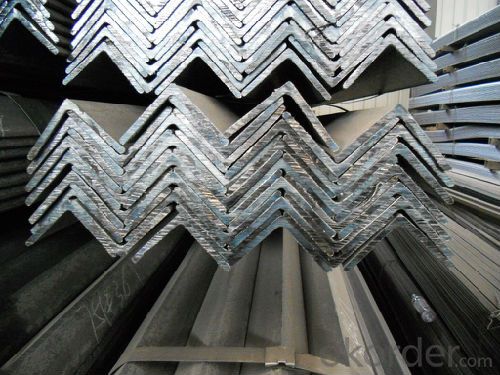
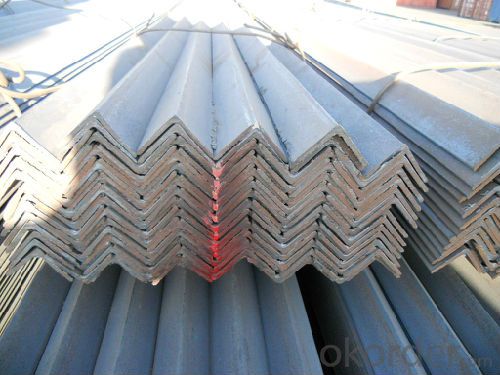
- Q: How do steel angles perform in terms of thermal conductivity?
- Steel angles have relatively low thermal conductivity compared to other materials. This means that they are not as efficient in conducting heat as materials such as aluminum or copper. However, steel angles still have moderate thermal conductivity, which allows them to dissipate heat to some extent. This property can be advantageous in certain applications where heat transfer needs to be controlled or balanced. Overall, while steel angles may not have the highest thermal conductivity, they still offer sufficient performance for many structural and construction purposes.
- Q: What is the fire resistance rating of steel angles?
- The fire resistance of steel angles relies on several factors, including the angle's size and thickness, the type of steel employed, and the specific fire protection measures implemented. Steel possesses inherent fire resistance due to its high melting point and low thermal conductivity. Nevertheless, the fire resistance can be improved by applying fireproofing materials, such as intumescent coatings or fire-resistant boards, to the steel angles. By providing insulation and slowing down heat transfer to the steel, these fire protection measures can significantly augment the fire resistance of steel angles. The specific fire resistance rating may differ depending on the thickness and type of fireproofing materials employed. For instance, a steel angle coated with a particular fireproofing substance may have a fire resistance rating of 60 minutes, signifying its ability to withstand fire exposure for up to 60 minutes without compromising its structural integrity. To determine the specific fire resistance requirements for steel angles in a specific application, it is crucial to refer to local building codes, regulations, and fire safety standards. These standards can offer guidance on the necessary fire protection measures and the minimum fire resistance ratings that must be met in different construction scenarios.
- Q: Are steel angles suitable for mezzanine floor construction?
- Yes, steel angles are suitable for mezzanine floor construction. Steel angles provide structural support and stability, making them a popular choice for building mezzanine floors. They are strong, durable, and can withstand heavy loads, making them an ideal choice for creating additional floor space in industrial or commercial settings.
- Q: How do you clean steel angles?
- To clean steel angles, you can follow a few simple steps. First, gather the necessary supplies: mild detergent or soap, warm water, a soft cloth or sponge, and a non-abrasive brush or scrub pad. Begin by filling a bucket or sink with warm water and adding a small amount of mild detergent or soap. Gently mix the solution until it forms a slight foam. Wet the cloth or sponge with the soapy water and gently scrub the steel angles, ensuring that all areas are covered and any dirt or grime is removed. For tougher stains or stubborn debris, use the non-abrasive brush or scrub pad to gently scrub the surface. Avoid using abrasive cleaners or steel wool, as they can scratch or damage the steel surface. It is also important to steer clear of acidic or corrosive cleaners, as they can cause discoloration or rusting of the steel. After thoroughly cleaning the steel angles, rinse them with clean water to eliminate any remaining soap residue. Use a clean, soft cloth to dry the angles and prevent water spots or streaks from forming. Regular cleaning and maintenance are crucial for keeping steel angles in their best condition and preventing corrosive damage. By following these steps, you can effectively clean steel angles and maintain their appearance for years to come.
- Q: How do you prevent galvanic corrosion in steel angles?
- There are several measures that can be taken to prevent galvanic corrosion in steel angles. 1. Utilizing a proper coating, such as paint, epoxy, or galvanization, can establish a barrier between the steel angle and other metals. This creates a separation, reducing the chance of galvanic corrosion. 2. Insulation materials, like rubber or plastic washers, gaskets, or sleeves, can be employed to isolate the steel angle from other metals. This prevents the flow of electrical currents and decreases the likelihood of galvanic corrosion. 3. It is crucial to consider the compatibility of different metals when designing structures or systems involving steel angles. Pairing metals with similar electrochemical properties can minimize the risk of galvanic corrosion. 4. Regular maintenance is essential in identifying and addressing early signs of galvanic corrosion in steel angles. This includes inspecting the protective coating for any damage, ensuring proper insulation, and applying appropriate remedies if corrosion is detected. By incorporating these preventive measures, the risk of galvanic corrosion in steel angles can be significantly reduced, guaranteeing their durability and structural integrity.
- Q: What are the common corrosion protection methods for steel angles?
- Steel angles can be protected from corrosion in multiple ways. The objective of these methods is to hinder or reduce the corrosion process caused by exposure to moisture or certain chemicals. Here are some widely used techniques for corrosion protection in steel angles: 1. Galvanization: This popular method involves coating the steel angle with a layer of zinc. The zinc acts as a sacrificial anode, corroding instead of the steel when exposed to moisture or chemicals. Galvanization provides excellent corrosion protection, significantly extending the lifespan of steel angles. 2. Painting: A layer of paint can serve as a barrier between the steel angle and its surroundings, preventing moisture and chemicals from reaching the surface. It is crucial to select the appropriate paint type designed specifically for corrosion protection and ensure proper surface preparation before painting. 3. Powder coating: This technique entails applying a dry powder to the steel angle, which is then heated and cured to form a durable and protective coating. Powder coating delivers excellent corrosion resistance and is commonly used in outdoor settings. 4. Epoxy coating: Epoxy coatings are frequently employed in corrosive environments like chemical plants or marine applications. These coatings exhibit high chemical resistance and create a protective barrier against corrosion. 5. Cathodic protection: This method involves utilizing the steel angle as the cathode in a galvanic cell, with a sacrificial anode connected to it. This arrangement initiates an electrochemical reaction that prevents corrosion. Cathodic protection finds application in structures such as underground pipelines or offshore platforms. It is essential to consider various factors such as the specific environment, expected service life, and budget while selecting a corrosion protection method. Seeking advice from corrosion protection specialists or engineers can assist in determining the most suitable approach for a particular application.
- Q: How much is a galvanized angle L50*50*5*2500
- The ordinary angle iron is 40-45 yuan one
- Q: How do you calculate the moment capacity of a steel angle?
- To calculate the moment capacity of a steel angle, several factors need to be considered. Firstly, the geometry of the angle needs to be determined, including the dimensions of the flanges and the web. The width of the flanges (b) and the thickness of the flanges (tf) and the web (tw) are crucial parameters. Next, the yield strength of the steel material needs to be known. This value represents the stress level at which the steel begins to permanently deform. It can be obtained from the material specifications or testing. The moment capacity of a steel angle can then be calculated using the following equation: Mn = Z × Fy Where: Mn is the moment capacity of the angle (in lb-ft or N-m) Z is the plastic section modulus of the angle (in^3 or mm^3) Fy is the yield strength of the steel material (in psi or MPa) The plastic section modulus (Z) is a measure of the shape's resistance to bending. It can be found in reference tables or calculated using equations specific to the angle's geometry. Once the values for Z and Fy have been determined, they can be plugged into the equation to calculate the moment capacity (Mn) of the steel angle. It is important to note that this calculation assumes elastic behavior of the steel angle and does not account for factors such as strain hardening or local buckling. Additionally, it is crucial to check the calculated moment capacity against the design requirements and safety factors to ensure the angle is suitable for the intended application.
- Q: Can steel angles be used in the construction of solar panel support structures?
- Yes, steel angles can be used in the construction of solar panel support structures. Steel angles are commonly used in the construction industry due to their strength and durability. They provide excellent support and stability, which is crucial for solar panel installations. Steel angles can be easily welded or bolted together to create strong and rigid structures that can withstand the weight of solar panels and the various environmental factors they may be exposed to, such as wind and snow loads. Additionally, steel angles can be customized to meet the specific design requirements of the solar panel support structure, making them a versatile choice for construction projects.
- Q: Can steel angles be used as handrails?
- Yes, steel angles can be used as handrails. Steel angles provide strength and stability, making them suitable for use as handrails in various settings such as stairs, ramps, balconies, and walkways. They can be welded or bolted securely to provide a reliable grip and support for individuals while navigating these areas.
Send your message to us
JIS SS400 Hot Rolled Angle Steel
- Loading Port:
- China Main Port
- Payment Terms:
- TT or LC
- Min Order Qty:
- -
- Supply Capability:
- -
OKorder Service Pledge
OKorder Financial Service
Similar products
Hot products
Hot Searches
Related keywords
